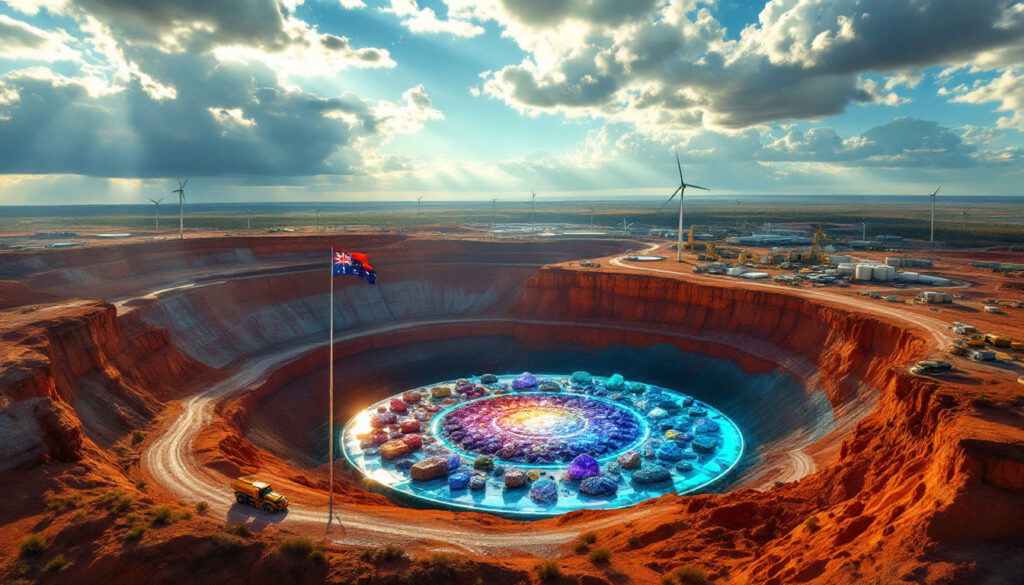Australia's National Critical Minerals Reserve: $1.2 Billion Investment
Australia is establishing a National Critical Minerals Reserve through a $1.2 billion AUD investment to reduce reliance on China for critical mineral supplies. This initiative aims to secure domestic production capabilities, enhance supply chain resilience, and position Australia as a global leader in mineral resource management. The reserve will involve strategic stockpiling, offtake agreements with producers, and infrastructure development, with operations slated to begin in late 2026 amidst growing critical mineral shortages impacting global markets.
What Is Australia's National Critical Minerals Reserve?
Key Components of the Reserve
The reserve combines four pillars: strategic stockpiling of high-demand minerals, offtake agreements to guarantee domestic production volumes, supply chain infrastructure investments, and a specialized task force to design implementation frameworks. Prime Minister Anthony Albanese emphasized the initiative leverages Australia's mineral wealth to address global supply chain vulnerabilities exposed by recent geopolitical tensions. According to the Australian government's critical minerals strategy, these resources are essential for modern technologies and defence applications.
Why Is Australia Creating a Critical Minerals Reserve?
Reducing Dependence on China
China currently controls 60-80% of global rare earth element processing and has implemented export restrictions on gallium, germanium, and graphite since 2023. These measures disrupted electric vehicle and solar panel manufacturing, prompting Australia to accelerate domestic capabilities. The reserve directly responds to China's export controls and U.S. tariffs on Chinese mineral imports, which created supply uncertainties for Western economies reliant on global rare earth reserves.
Enhancing Economic Resilience
Australia holds the world's largest reserves of lithium (47.3% of global supply) and ranks second in cobalt and rare earth elements. By 2030, global demand for lithium-ion batteries is projected to grow 500%, creating a $400 billion market opportunity. The reserve aims to capture value-added processing activities, which currently account for less than 10% of Australia's mineral export revenue. This approach aligns with shifting Australia's mining sector trends toward downstream processing.
How Will the $1.2 Billion AUD Investment Be Allocated?
Stockpiling Strategy
Phase 1 (2024-2026) prioritizes lithium, cobalt, and heavy rare earth elements, with $500 million allocated for initial purchases. Storage facilities will be co-located with mining hubs in Western Australia and Queensland to minimize logistics costs.
Producer Support Mechanisms
A $700 million fund will underwrite offtake agreements, providing producers with guaranteed pricing over 5-10 year contracts. This stabilizes revenue streams for miners like Lynas Rare Earths and Pilbara Minerals while incentivizing $2.4 billion in private sector co-investment. The Chamber of Minerals and Energy of Western Australia has noted that this strategic reserve will support investment in vital commodities for national security and energy transition.
When Will the National Critical Minerals Reserve Be Operational?
Implementation Timeline
-
Q3 2024: Task force finalizes mineral prioritization framework
-
Q1 2025: First round of offtake agreements signed
-
Q3 2026: Initial stockpiles reach 30,000 tonnes of lithium carbonate equivalent
-
Q4 2026: Full operational capacity achieved
Which Critical Minerals Will Be Prioritized?
Strategic Mineral Categories
-
Battery minerals: Lithium (spodumene concentrate), cobalt, nickel
-
Renewables infrastructure: Copper, silicon, silver
-
Defense applications: Titanium, tungsten, rare earth magnets
Selection Criteria
Minerals are evaluated using a 10-point system assessing supply risk (40% weight), economic impact (30%), and processing maturity (30%). Lithium scores 8.7/10 due to 90% concentration in Chinese refining capacity. Furthermore, strategic lithium investments are reshaping the future of mining globally.
How Does This Compare to International Critical Mineral Initiatives?
| Initiative | Investment | Key Focus | Stockpile Target |
|---|---|---|---|
| Australia NCMR | $1.2B AUD | Full supply chain security | 15 critical minerals |
| U.S. Defense Production Act | $750M USD | Rare earth processing | 8 minerals |
| EU Critical Raw Materials Act | €2B | Recycling infrastructure | 10 minerals |
Australia's model uniquely integrates stockpiling with domestic processing incentives, contrasting with U.S. emphasis on defense needs and EU circular economy priorities. These differences reflect varied approaches to global commodities insights and regional priorities.
What Are the Economic Implications for Australia?
Industry Development Benefits
-
14,000 new jobs in regional mining communities by 2028
-
$7.8 billion potential GDP contribution from mineral processing
-
300% increase in battery material exports by 2030
Investment Opportunities
The plan unlocks four key sectors:
-
Midstream processing: Lithium hydroxide plants
-
Recycling technologies: Black mass recovery systems
-
Infrastructure: Dedicated mineral railways and ports
-
Technology: AI-driven exploration systems
FAQ About Australia's National Critical Minerals Reserve
What prompted Australia's accelerated timeline?
China's November 2023 graphite export restrictions, which impacted 95% of Australia's battery anode supply, forced rapid policy response.
How will the task force ensure environmental compliance?
All projects must meet National Environmental Protection Act standards, with 30% of funding contingent on achieving net-zero mining certifications.
What safeguards prevent market distortion?
Price ceilings in offtake agreements are pegged to 80% of global benchmarks, adjusted quarterly via independent audits.
This comprehensive approach positions Australia to control 25% of global critical mineral supply chains by 2035 while addressing strategic vulnerabilities. The australia national critical minerals reserve represents a significant shift in national resource policy that could reshape global mineral markets for decades to come.
Want to Capitalise on Australia's Critical Minerals Boom?
Discover how savvy investors are positioning for significant returns as Australia invests $1.2 billion in critical minerals with Discovery Alert's proprietary Discovery IQ model, which provides instant notifications on ASX mineral discoveries and emerging opportunities. Visit our discoveries page to understand why major mineral discoveries can lead to substantial market returns and begin your 30-day free trial today.




